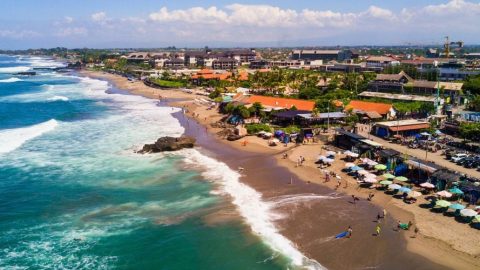Editor’s Note — Monthly Ticket is a new CNN Travel series that spotlights some of the most fascinating topics in the travel world. In April, we’re setting course for the diverse world of cruises. Whether you’re looking for travel inspiration or insider knowledge, Monthly Ticket will take you there.
(CNN) — After two years of navigating relentlessly choppy seas, the cruise industry — one of the sectors of tourism hardest hit by the pandemic — is forecasting significantly smoother sailing ahead.
Facing persistent pandemic pressures and increasingly urgent demands around climate action, industry innovation and adaptation has been the name of the game.

Virgin Voyages’ Valiant Lady made its debut in March 2022.
Gregg Wolstenholme/Bav Media/Shutterstock
CLIA forecasts passenger numbers will not only meet but exceed pre-pandemic levels by the end of 2023. And according to Cruise Industry News’ cruise ship orderbook for ocean-going vessels, nearly 40 new ships are lined up to debut this year alone, with more than 75 vessels on order through 2027.
Industry insiders say the pent-up cruiser demand is there.
“The industry only operated for two-and-a-half months in 2020, and partially in 2021, so there are essentially 20-plus months of cruise passengers that did not get their vacations,” explains Monty Mathisen, managing editor for Cruise Industry News.
Assuredly, cruising is back, if with a slightly different look and feel. Here’s where the future of cruising currently stands for 2022 and beyond.
Continuing pandemic-driven protocols
CNN’s Natasha Chen reports from aboard the Celebrity Edge, the first cruise ship to sail out of a US port in more than 15 months.
Cruise lines have implemented stringent health and safety measures in response to the pandemic, which CLIA spokesperson Laziza Lambert says are “some of the highest levels of Covid-19 mitigation compared to virtually any other commercial setting.”
McDaniel says consumer confidence is high as a result.
“Among cruisers, we’re told they feel more comfortable cruising than they do flying, staying at a hotel, attending an indoor event, and even attending a house party with a number of guests outside of their family,” says the editor.
Those measures include vaccination mandates, pre-cruise testing, advanced ventilation systems, deep-cleaning protocols, and the elimination of high-touch surfaces (for instance, buffets are now manned by crew rather than self-served). Some lines are still requiring masking and encouraging social distancing via reduced capacity, although those policies are easing.
“I’ve heard a lot of positive comments on the ships being less than full, and how that has driven a better onboard experience,” Mathisen says, adding, however, “That will be coming to an end soon.”
But some of the newer crowd-reduction measures are likely to stick around, and proving to be vacation value-adds for travelers, like more streamlined boarding at embarkation and the replacement of in-person muster drills with virtual ones.

Passengers check into their cruise in Fort Lauderdale, Florida, on June 26, 2021. Celebrity Edge was the first cruise ship to leave a U.S. port since the coronavirus pandemic brought the industry to a 15-month standstill.
Marta Lavandier/AP
“Many of the pain points of the cruise experience were around the first day — check-in, muster, etc.,” says Mathisen, “And those all have a new look.”
Notable, too, has been the pandemic’s continuing impact on itineraries, given the patchwork of shifting international restrictions around cruise ship access. Promisingly for the industry, some major destinations are lifting cruise ship bans in 2022 for the first time in two years, including Canada and Australia.
Many ports will continue to require proof of vaccination or negative Covid-19 tests for passengers to disembark — and port policies can shift alongside the ebb and flow of pandemic waves.
McDaniel says that because of such volatility, flexible cancellation policies are the number one consideration for would-be cruisers. However, she advises: “Cruise lines are beginning to alter their cancellation policies from what we saw earlier in the pandemic, so it’s important to be sure you’re familiar with your line-of-choice’s policy before you book.”
Greener ship technology
Pioneering cruise lines are now pursuing a variety of new and more sustainable alternative energy sources to green their fleets, including electric batteries, biofuels and hydrogen fuel cells.
Norway-based Hurtigruten is behind the world’s first hybrid electric-powered cruise ship, the three-year-old MS Roald Amundsen; the company has since added on two more hybrid ships, with three more upcoming, and has announced plans for a zero-emissions ship by 2030. They banned HFO over a decade ago, and are currently experimenting with biofuels.

Hurtigruten’s MS Roald Amundsen in Duse Bay, Antarctica.
Oscar Farrera
Asta Lassesen, CEO of Hurtigruten Expeditions, says the company hopes to lead by example since “the only way forward for the cruise industry is a more sustainable one.”
“Unfortunately, we see that large parts of the cruise industry are dragging their feet, powering ships with polluting heavy fuel oil and flooding tiny communities with thousands of people at once,” she adds.
Some like-minded cruise lines are joining ranks, like luxury line Ponant, which debuted an electric hybrid ship last year, and upscale Silversea Cruises, which has a hybrid vessel lined up for 2023. Meanwhile, Italian mainstream line MSC Cruises has ambitions to develop the world’s first hydrogen-powered cruise ship.
CLIA reports that more than half of the industry’s new cruise ships will rely on liquified natural gas (LNG). Yet industry watchdogs like Marcie Keever at environmental advocacy group Friends of the Earth caution that LNG is merely a distraction and yet another significant pollutant.
“The cruise industry shifting to LNG will just lock them in to a failed fossil-fuel technology for another 30 to 40 years,” she says.
The industry is also eyeing emissions-reduction measures via shore-power connectivity, which allows ships to turn off their engines and plug in while in port. CLIA will have enabled 174 ships with such connectivity by 2027 — though as few as 14 global ports are currently enabled with compatible infrastructure.
Smaller ships
Even prior to the pandemic, cruisers were showing an affinity for smaller, more intimate ships, with a boon of riverboats and expedition vessels now on order.
Existing cruise lines like Viking and Seabourn are branching out into the expedition market this year, while entirely new brands like Atlas Ocean Voyages and The Ritz-Carlton Yacht Collection are expanding the small-ship space.

Viking’s two new expedition ships each feature a luxurious Owner’s Suite.
Viking
While priced at a premium, these smaller ships offer distinct appeal in a post-pandemic world, like fewer crowds and access to more exotic, bucket-list locales that are otherwise inaccessible to larger cruise ships.
“Very simply put: Size does matter,” says Lassesen, of Hurtigruten. “An expedition cruise ship has a smaller footprint than a mega-ship.”
Contactless technology
The pandemic has also accelerated a technological revolution aboard cruise ships, with newly digitized features enabling a more convenient — and contactless — environment onboard.
Smartphones and wearable tech like bracelets or medallions now commonly double as boarding passes and keycards; some wearable devices even allow guests to track traveling companions onboard.
In restaurants, QR codes are replacing traditional printed menus, while cruise line mobile apps continue to evolve to help cruisers book meals, spa treatments, shows, activities and excursions with the push of a button.
The bottom line
McDaniel thinks the industry is well-positioned to navigate any pandemic-related challenges that may lie ahead.
“Based on trends we’ve seen around variants, their effect on bookings have a short shelf life,” she says. “So assuming similar patterns continue, we can expect the industry to be in a good position.”
Yet when it comes to sustainability, the industry still has a long way to go, say experts like Keever.
“Sadly, there is an incredible amount of greenwashing going on,” she says, adding that government regulation and oversight is needed “to force the industry to improve its environmental behavior and work to actually protect the communities and marine environments they travel to.”
What’s certain is that there are high economic stakes tied in to the industry’s resilience.
Pre-pandemic, the cruise sector contributed $154 billion to the global economy, according to CLIA — that number dipped nearly 60%, to $63.4 billion for 2020, and led to the loss of half of cruise-supported jobs around the world (totaling 576,000).




Recent Comments